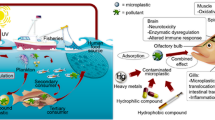Abstract
There are often many chemicals coexisting in aquatic ecosystems, and information the joint toxicity of a mixture of organic pollutants on microorganisms is scarce at present. Acute toxicity of aromatic anilines and phenols and their mixtures to alga was determined by the algae inhibition test. The median effective inhibition concentration EC50 values for single compounds and EC50mix values for binary and multiple mixtures were obtained. The joint toxic effects of mixtures were estimated by using mixture toxicity index method. The structural descriptors of the n-octanol/water partition coefficient (log P mix) and the frontier orbital energy gap (ΔE mix) for mixtures were calculated. Based on the quantitative structure–activity relationship model for single chemical toxicity log(1/EC50) = 0.579log P − 0.783ΔE + 8.966 (n = 11, r 2 = 0.923), the following two-descriptor model was developed for the toxicity of a mixture: log(1/EC50mix) = 0.416log P mix − 0.584ΔE mix + 7.530 (n = 27, r 2 = 0.944). This model can be used successfully to predict the toxicity of a mixture, whether binary mixtures in variant toxic ratios (4:1, 2:1, 1:1, 1:2 and 1:4) or multiple mixtures of three or four chemicals at an equitoxic ratio are used as predictors.

Similar content being viewed by others
References
Backhaus T, Faust M, Scholze M, Gramatica P, Vighi M, Grimme LH (2004) Joint algal toxicity of phenylurea herbicides is equally predictable by concentration addition and independent action. Environ Toxicol Chem 23:258–264
Bradbury SP (1994) Predicting modes of toxic action from chemical structure: an overview. SAR QSAR Environ Res 2:89–104
Christensen ER, Chen CY (1989) Modeling of combined toxic effects of chemical. Hazard Assess Chem 6:125–186
Cronin MTD, Schultz TW (1996) Structure-toxicity relationships for phenols to Tetrahymena pyriformis. Chemosphere 32:1453–1468
Huang H, Wang X, Shao Y, Chen D, Dai X, Wang L (2003) QSAR for prediction of joint toxicity of substituted phenols to tadpoles (Rana japonica). Bull Environ Contam Toxicol 71:1124–1130
Kamlet MJ, Doherty RM, Taft RW, Abraham MH (1986) Solubility properties in polymers and biological media. 7. An analysis of toxicant properties that influent inhibition of bioluminescence in Photobacterium phosphoreum (The Microtox Test). Environ Sci Technol 20:690–695
Könemann H (1981) Fish toxicity tests with mixtures of more than two chemicals: a proposal for a quantitative approach and experimental results. Toxicology 19:229–238
Könemann H, Musch A (1981) Quantitative structure-activity relationships in fish toxicity studies Part 2: the influence of pH on the QSAR of chlorophenols. Toxicology 19:223–228
Lin ZF, Du JW, Yin KD, Wang LS, Yu HX (2004) Mechanism of concentration addition toxicity: they are different for nonpolar narcotic chemicals, polar narcotic chemicals and reactive chemicals. Chemosphere 54:1691–1701
Lu GH, Yuan X, Wang C (2003) Quantitative structure-toxicity relationships for substituted aromatic compounds to Vibrio fischeri. Bull Environ Contam Toxicol 70:832–838
Lu GH, Yuan X, Zhao YH (2001) QSAR study on the toxicity of substituted benzenes on the algae (Scenedesmus obliquus). Chemosphere 44:437–440
Marking LL, Dawson VK (1975) Method of assessment of toxicity or efficacy of mixtures of chemical. US Fish Wildl Serv Invest Fish Control 67:1–8
Mayer FL, Hamelink JL (1977) Aquatic toxicology and hazard evaluation. ASTM STP 634 Publication, Philadelphia, pp 99–108
Mielczarek C (2005) Acid-base properties of selected flavonoid glycosides. Eur J Pharm Sci 25:273–279
OECD (1981) Test guideline 201. Paris Decision of the Council C 81:320–323
Placket RL, Hewlett PS (1967) A comparison of two approaches to the construction of models for quantal response to mixtures drugs. Biometrics 23:27–44
Schultz TW, Holcombe TW, Phipps GL (1986) Relationships of quantitative structure-activity to comparative toxicity of selected phenols in the Pimephales promelas and Tetrahymena pyriformis test systems. Ectotoxicol Environ Saf 12:146–153
Schultz TW, Wesley SK, Baker LL (1989) Structure-activity relationships for di and tri alkyl and/or halogen substituted phenols. Bull Environ Contam Toxicol 43:192–198
Walsh GE, Duke KM, Foster RB (1982) Algae and crustaceans as indicators of bioactivity of industrial wastes. Water Res 16:879–883
Xu S, Nirmalakhandan N (1998) Use of QSAR models in predicting joint effect in multi-component mixtures of organic chemicals. Water Res 32:2391–2399
Yan XF, Xiao HM, Gong XD, Ju XH (2006) A comparison of semiempirical and first principle methods for establishing toxicological QSARs of nitroaromatics. J Mol Struct: Theochem 764:141–148
Yuan X, Lu GH, Zhao JS (2002) QSAR study on the joint toxicity of 2,4-dinitrotoluene with aromatic compounds to Vibrio fischeri. J Environ Sci Health A 37:573–578
Acknowledgments
This work was supported by Program for New Century Excellent Talents in University (05-0481) and the National Natural Science Foundation of China.
Author information
Authors and Affiliations
Corresponding author
Rights and permissions
About this article
Cite this article
Lu, G., Wang, C., Tang, Z. et al. Joint toxicity of aromatic compounds to algae and QSAR study. Ecotoxicology 16, 485–490 (2007). https://doi.org/10.1007/s10646-007-0153-1
Received:
Accepted:
Published:
Issue Date:
DOI: https://doi.org/10.1007/s10646-007-0153-1




